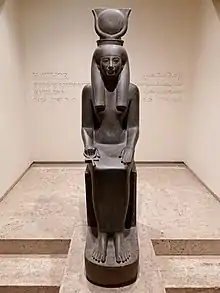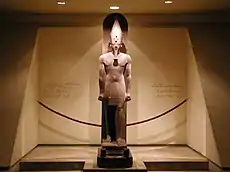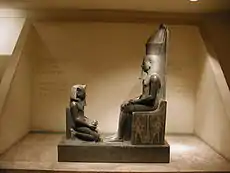
Seated statue of goddess Hathor
The Luxor statue cache is a grouping of ancient Egyptian statues unearthed in 1989.[1] They were discovered in Luxor, beneath the solar court of the 18th Dynasty Pharaoh Amenhotep III.
Partial list of statues
- Thutmose III as sphinx, alabaster, 1.095 metres (3 ft 7 in)
- Amenhotep III, standing, red quartzite, 2.49 metres (8 ft 2 in)
- the goddess Iunyt, seated, grey granite 1.45 metres (4 ft 9 in)
- Tutankhamun as sphinx, alabaster (with paint remains) 0.56 metres (1 ft 10 in)
- Horemheb, kneeling holding offering pots, diorite 1.91 metres (6 ft 3 in)
- Amun-Re-Kamutef serpent, grey granite 1.52 metres (5 ft 0 in)
- Amun-Re-Kamutef serpent, grey granite 1.00 metre (3 ft 3 in)
- Goddess Taweret, sandstone, 0.61 metres (2 ft 0 in)
History
The excavation was launched in 1989 under the authority of Mahammed el-Saghir, with routine maintenance by the Luxor antiquities inspectorate. The Luxor cache was buried during the Roman conversion of the area into a military camp.[2] Originally five statues were found at a three-foot depth below a covering layer of small stones; eventually 26 statues were uncovered with some being damaged prior to burial.
 Amenhotep III standing upon Sled of God Tem (oldest creator god Atum)
Amenhotep III standing upon Sled of God Tem (oldest creator god Atum) Horemheb kneeling
Horemheb kneeling
Notes
References
- Reeves, Nicholas (2000). "The Luxor Statue Cache". Ancient Egypt, The Great Discoveries, a Year-by-Year Chronicle. London: Thames and Hudson Ltd. pp. 226–228. ISBN 0-500-05105-4.
This article is issued from Wikipedia. The text is licensed under Creative Commons - Attribution - Sharealike. Additional terms may apply for the media files.